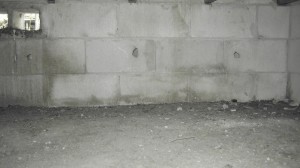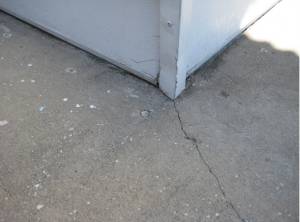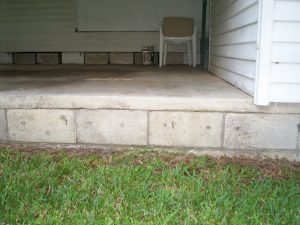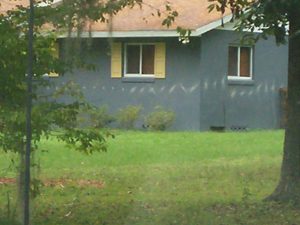Whenever I go to a home or business for the first time I always look for drill marks, I ask the homeowner “when was it treated?” and sometimes they are amazed that I knew it was. For some it was before they moved in and many people have no idea what those little round cement patches are on their front stoop and they give inquisitive looks when they find out. You see, with the surprise also comes a nagging question of why, how, where and when.
Now comes the fun part of answering the questions and although you can’t glean everything about the work, an experienced professional can actually narrow down quite a bit of information in just a few short minutes. Here are a few examples of what one might say; CLICK ON THE PICS FOR THE BEST VIEW.
 “Ms. Smith, the drill marks in your crawl space weren’t made from a modern termite hammer drill. These were made with a hammer and a chisel and then chemical was pumped in. I’d say this job was done over 30 years ago just by the way they were drilled, maybe longer.”
“Ms. Smith, the drill marks in your crawl space weren’t made from a modern termite hammer drill. These were made with a hammer and a chisel and then chemical was pumped in. I’d say this job was done over 30 years ago just by the way they were drilled, maybe longer.”
 “Sir, your attached shed here has no expansion joint in which the termite tech was trying to block off termite entry. What it does show is this hair line crack and termites only need 1/64th of an inch to get in. My guess is you had a tech who saw this as a potential problem and drilled out the slab to prevent it or that the termites already had the crack in use and he had to stop them. Let’s take a peak inside the shed and see if we can confirm that shall we?”
“Sir, your attached shed here has no expansion joint in which the termite tech was trying to block off termite entry. What it does show is this hair line crack and termites only need 1/64th of an inch to get in. My guess is you had a tech who saw this as a potential problem and drilled out the slab to prevent it or that the termites already had the crack in use and he had to stop them. Let’s take a peak inside the shed and see if we can confirm that shall we?”
 “By the looks of these drill marks I’d guess this carport at one time was enclosed with walls. It’s highly unlikely a termite barrier would be needed here because there is no wood for them to eat or any area where they could tunnel up into the house. Also the slab is over the block creating its own physical barrier. Termite work is hard enough and I doubt anyone would do extra drilling in unnecessary places. It may be over time that it was converted back into an open carport or even at the time of the work because of termite damage. I can understand under the attached shed area being treated but I see no reason for the marks going away from it. There may be more to the story we’ll never know.”
“By the looks of these drill marks I’d guess this carport at one time was enclosed with walls. It’s highly unlikely a termite barrier would be needed here because there is no wood for them to eat or any area where they could tunnel up into the house. Also the slab is over the block creating its own physical barrier. Termite work is hard enough and I doubt anyone would do extra drilling in unnecessary places. It may be over time that it was converted back into an open carport or even at the time of the work because of termite damage. I can understand under the attached shed area being treated but I see no reason for the marks going away from it. There may be more to the story we’ll never know.”
 “I’ll be honest sir, I’m not sure what they were thinking. To drill a home like this leads me to believe the technician either couldn’t get in to the crawl space or didn’t want to. Normally the drilling is much lower, just above grade and I couldn’t even guess why they went so high. Since formosan termites are not known in this area there’d be no other reason to do this. I’d better see what I can find out in the crawl space for you.” (what the tech is really thinking would be;)
“I’ll be honest sir, I’m not sure what they were thinking. To drill a home like this leads me to believe the technician either couldn’t get in to the crawl space or didn’t want to. Normally the drilling is much lower, just above grade and I couldn’t even guess why they went so high. Since formosan termites are not known in this area there’d be no other reason to do this. I’d better see what I can find out in the crawl space for you.” (what the tech is really thinking would be;)
WOW, what lazy guy did this?
Ok, so that’s a few beauties for you but others might be when you just find a few drill marks by a bay window or front door and no where else. This indicates a partial treatment and 9 times out of 10 there was a problem there but for some reason a complete job was not done. Other telling signs would be a bunch of drill marks in one certain area while the rest of the marks looked more evenly spaced. This too indicates an area that perhaps needed a retreat or two because the termite kept coming back. Also some companies use plastic plugs while others use cement, seeing both on a structure lets you know you’ve had at least two different treatments and perhaps by different companies. I’m sure there are more examples and if I’ve forgotten any or you know of some not listed let us know. If you have a pic that would be awesome, just send it along using our picture upload on the Ask the Bug Doctor page. Just remember, every drill mark has a story and we’d all love to hear some you have heard.




